
There are so many different types of white birds out there that compiling them on a single list and giving each one the descriptive analysis it deserves would make for a long book. Most of the white birds on our list feature stunning white plumage but aren’t entirely white.
There’s always a blue beak, beady black eyes, yellow or black legs, or different color feathers. Finding a bird with white contour, flight, down, semiplume, filoplume, and bristle feathers is a rare feat. So, while the birds on this list are “white” birds, they aren’t always entirely white.
The feature that truly separates them from the flock (pun intended) is their pristine, white plumage. Despite the lack of color, these birds still manage to display a stunning level of beauty. That said, here is our list of 15 different types of white birds, along with some interesting info about each.
1. White Hawk (Pseudastur albicollis)

With white plumage on their bodies and black plumage on their wings, white hawks are truly striking birds.
©Chelsea Sampson/Shutterstock.com
Why not start our list with a true bird of prey? The white hawk is a truly impressive white bird, though it features black wing tips and black tail feathers. The dash of blacks in the wings and tail push the white plumage to the forefront and the contrast couldn’t be more breathtaking.
Female white hawks are larger and heavier than their male counterparts but, generically speaking, the white hawk is between 18″ and 22″ in length and weighs about a pound and a half. There are also four subspecies of white hawks, with the Southern Mexico white hawk being the closest to pure white.
2. Ivory Gull (Pagophila eburnea)
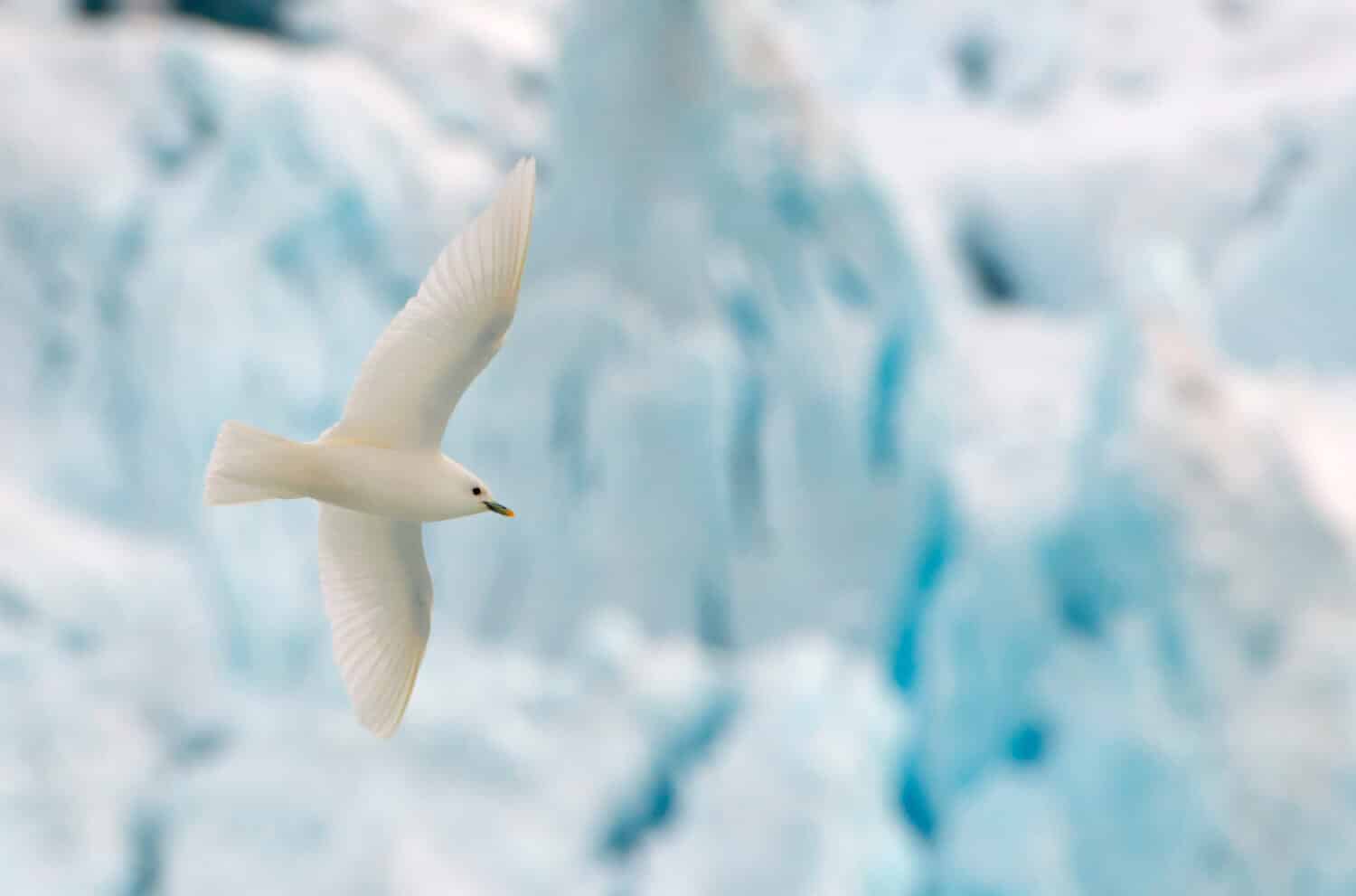
While its beak is gray and its legs are black, the rest of the ivory gull is purely white.
©Agami Photo Agency/Shutterstock.com
The ivory gull is one of the few white birds on our list that is almost entirely white. The beak is a light shade of gray and the black legs stand out in contrast to the pure, snow-white plumage. The ivory gull has a wingspan of up to 47″, a length of 15.5″ to 17″, and a weight between 16 and 24 ounces.
In other words, ivory gulls are similar in size and shape to a pigeon. This is a difficult bird to find in North America. You have to head to the Canadian Arctic to have a good sighting opportunity or head over to Greenland or Iceland. Ivory gulls are probably the most raucous of the different types of white birds on our list.
3. Snowy Owl (Bubo scandiacus)
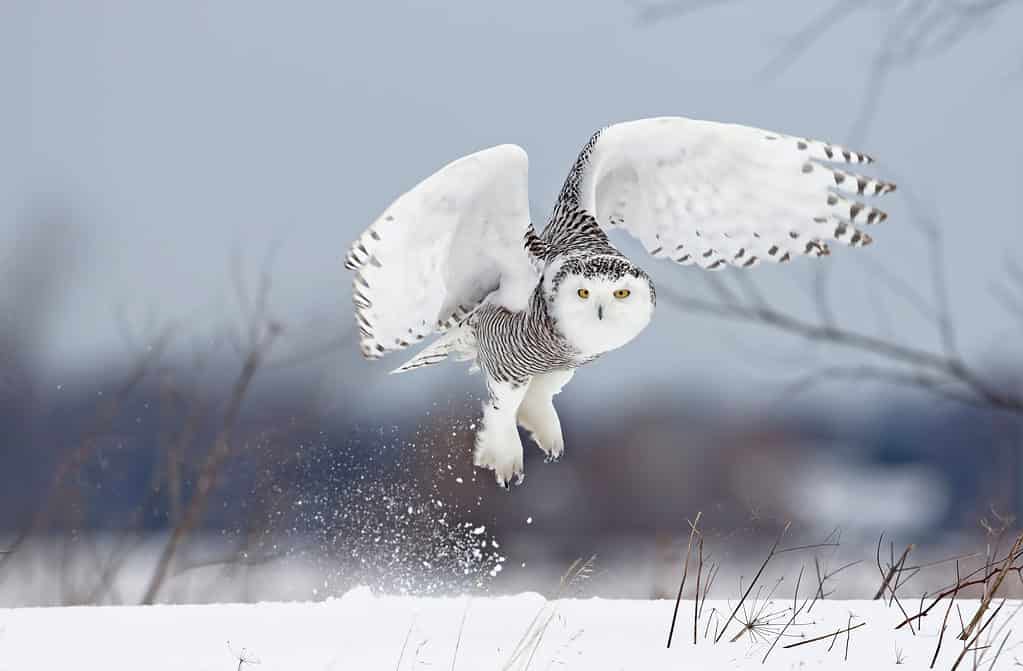
A randomized pattern of black markings distinguishes the snowy owl.
©Jim Cumming/Shutterstock.com
No list of white birds would be complete without the bird that helped make Harry Potter famous. All owls are beautiful birds of prey but the snowy owl simply stands apart. It’s not entirely white, featuring a randomized pattern of black markings amid the thick plumage.
It’s also a tough bird of prey to spot since the snowy owl prefers a more solitary existence. The snowy owl is often labeled a “nomadic” bird, even though it’s one of those rare owl breeds that tend to hunt more throughout the day than at night. Though it has black talons, the feet of a snowy owl is often covered in puffy, white down feathers, like a comfortable pair of slippers.
4. Great Egret (Ardea alba)
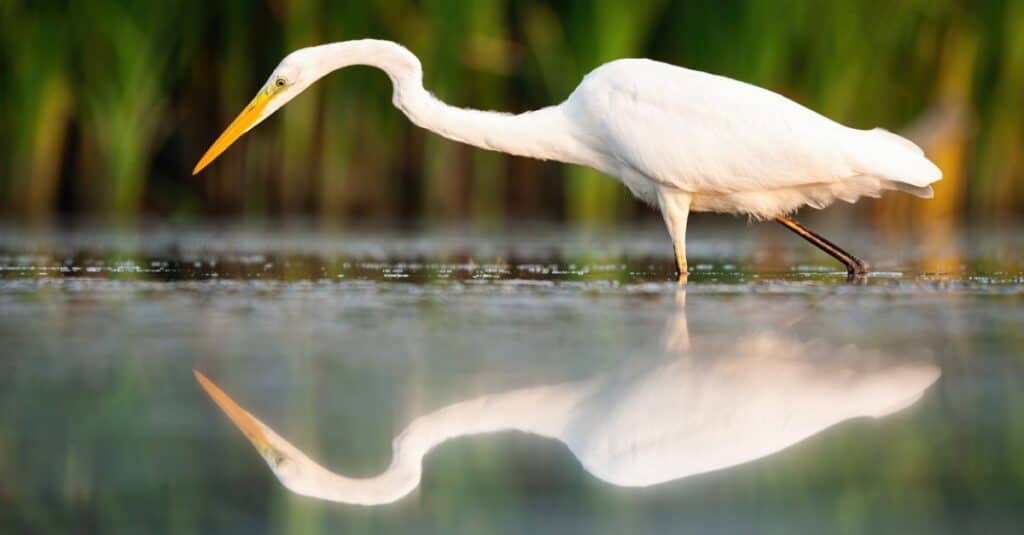
Great egrets aren’t cranes, but they have a similar appearance to cranes.
©WildMedia/Shutterstock.com
When most people see the great egret, they assume they are looking at a crane. While it’s not a crane, it goes by many names—great white egret, common egret, large egret, and great white heron. Regardless of the name, it’s a very large bird with mostly white plumage and long legs meant for wading through shallow waters and hunting for fish.
The great egret is a member of the heron family and though it’s mostly white, the long, strawlike legs are a glossy black, with a yellow beak and up to a 67″ wingspan. Great egrets are found in North America, Africa, Europe, Canada, and Asia. Great egrets spent nearly a century on the list of birds necessitating conservation but, today, they are no longer on those lists.
5. American White Pelican (Pelecanus erythrorhynchos)
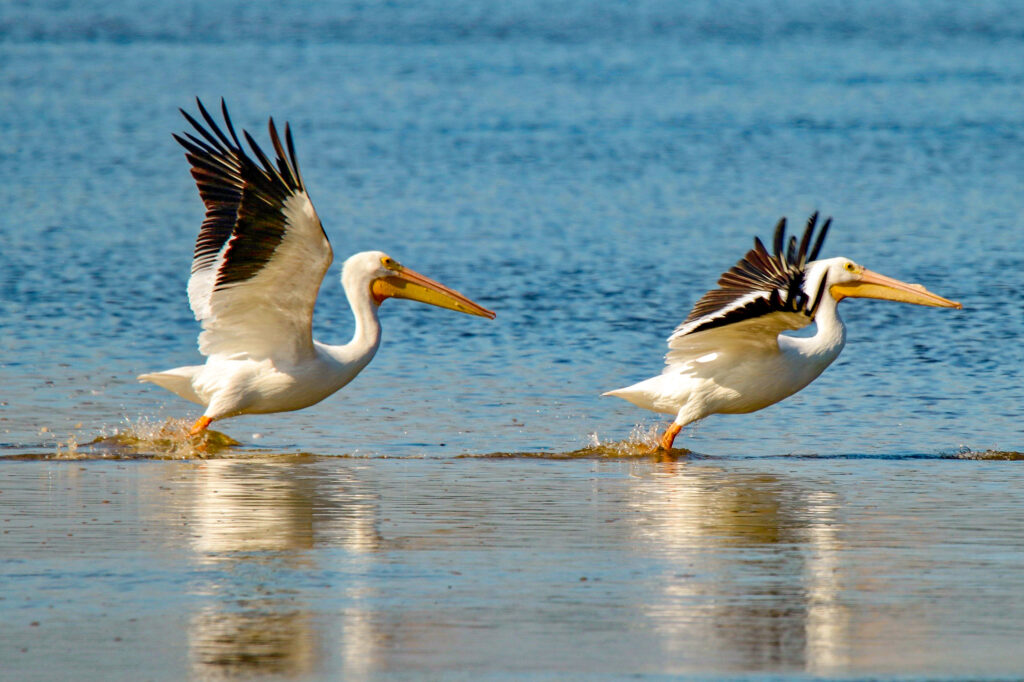
The wingspan of American white pelicans is huge, reaching up to 120 inches.
©Susan Rydberg/Shutterstock.com
One of the largest birds on our list is the American white pelican. The overall length of the bird is 70″, with a massive wingspan of up to 120″. Like most pelicans, its beak is yellow and enormous, with a large throat sac for scooping up scores of tiny fish the pelican spots swimming in schools near the surface.
While some birds are large, due to their heavy plumage, the American white pelican has the weight to match its girth, often pushing over 20 pounds. These birds are highly social and are almost always spotted in nesting colonies. American white pelicans range from Canada to Florida and consume up to 4 pounds of food every day, which is the highest daily intake of the different types of white birds.
6. Masked Booby (Sula dactylatra)
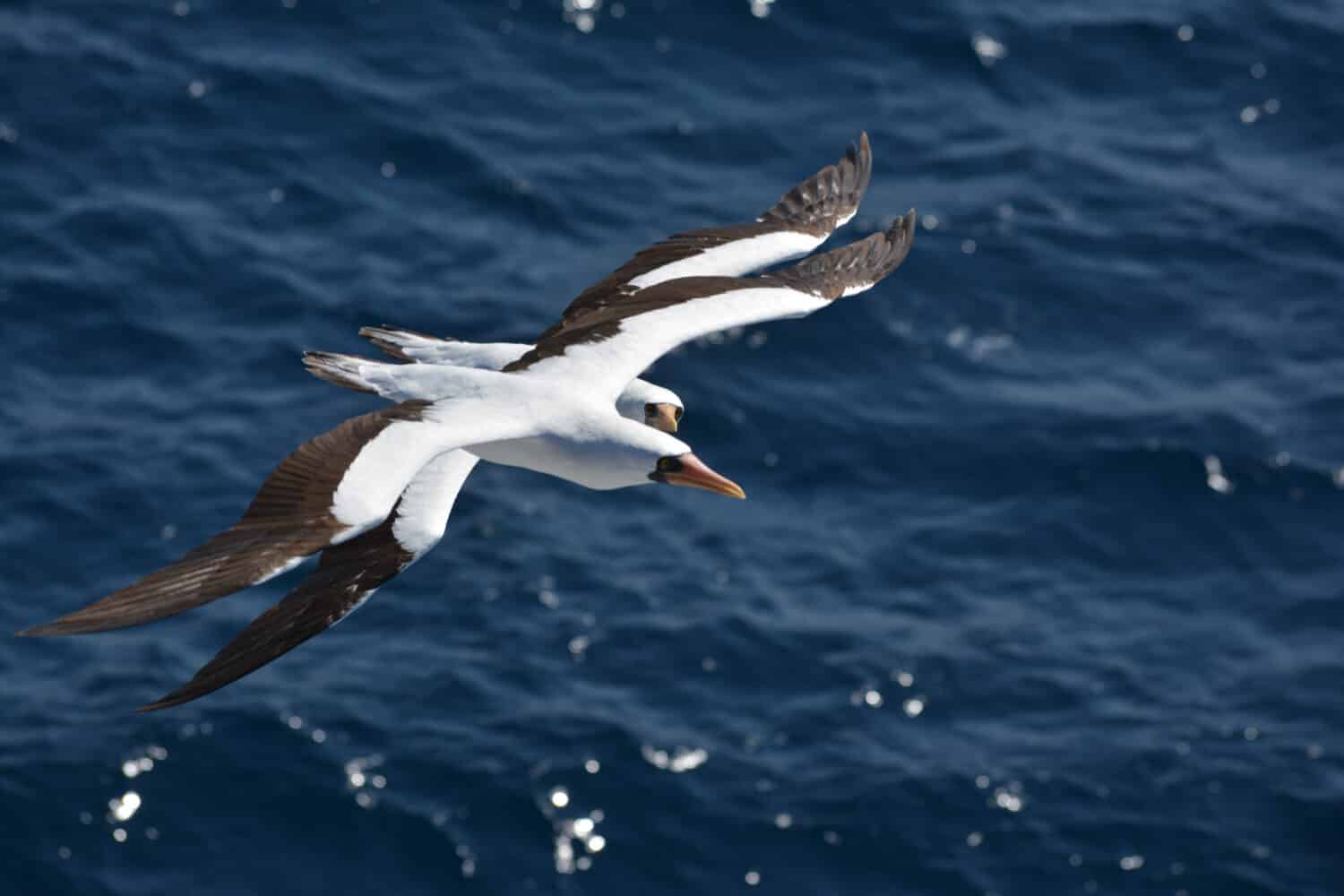
Similar to white hawks, the masked booby has black plumage on its wings.
©sushil20087817/Shutterstock.com
The masked booby looks like it’s wearing some sort of mask that starts, of course, with its large, pointed beak. Like the white hawk, the masked booby has black feather tips and a black tail, along with the small, black outline around the eyes that gives it the impression of wearing a mask.
Reaching up to 33″ in length, with a wingspan of up to 67″, it’s a fairly large bird, approaching the American white pelican. Though they feature black wing tips and tails, masked booby birds are nearly half and half black and white as juveniles, with the white plumage taking over as they reach adulthood. Another neat feature they share with American white pelicans is their predilection toward nesting colonies.
7. Phillippine Cockatoo (Cacatua haematuropygia)

With red feathers on the underside of its tail, the Philippine
cockatoo
is a beautiful bird.
©slowmotiongli/Shutterstock.com
Native to the Phillippines, the Phillippine cockatoo features a majority white plumage with faded or pale yellow under-feathers and some deceptively hidden red under-tail feathers. It’s difficult to see the red in the under-tail unless the bird takes flight and you can spot them from beneath.
Overall, the Phillippine cockatoo is a relatively small bird, with an 8.5″ wingspan and a 12″ length. Despite their small, out-of-the-way size, these beautiful white birds are on the IUCN Red List and considered to be endangered to a critical point. Cockatoos are relatively popular as pets in the U.S. and the Phillippine Cockatoo highly resembles these more domesticated cousins.
8. Rock Ptarmigan (Lagopus muta)

While many rock ptarmigans are nearly pure white, streaks of gray throughout mean some are less white than others.
©Tatiana Ivkovich/Shutterstock.com
Mostly found in North America, Asia, and Europe, the rock ptarmigan is a strikingly white bird, often extremely well-camouflaged when landing in the snow. Members of the “grouse” family, the rock ptarmigan isn’t exactly pure white. There are slightly gray streaks among their plumage, though these streaks are very light and few and far between.
Male rock ptarmigans are very loud and vocal. If you hear a rock ptarmigan, it’s a male 99% of the time. These little omnivores are only about 14″ in length, with a wingspan capable of reaching 24″. They are considered to be “large” birds and they’re also one of the prettiest on our list of different types of white birds.
9. Snowy Egret (Egretta thula)
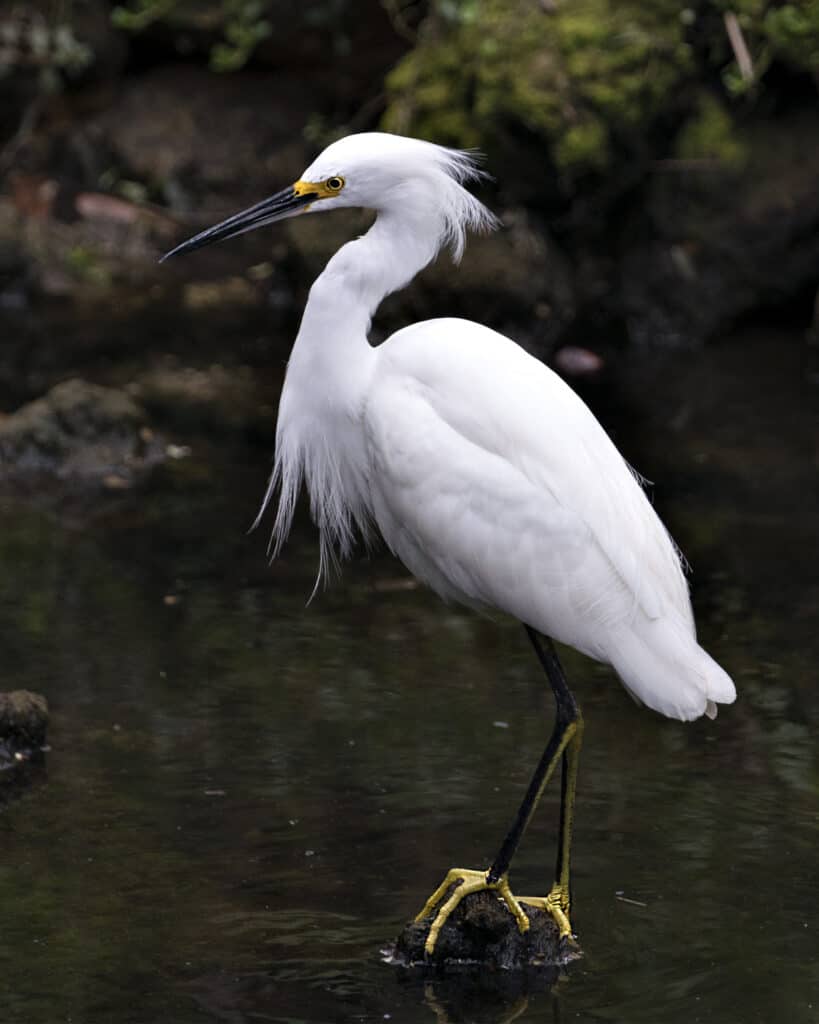
Being so similar, it’s tough to distinguish snowy egrets from giant egrets.
©iStock.com/Rejean Bedard
The snowy egret is the second egret on our list and honestly, they are challenging to separate from the giant egret, especially from a distance. Both birds look very similar. The biggest and most telling factor is the size difference between the two. Snowy egrets are one of the smallest in the heron family, only reaching 22″ to 26″ in length, with a 40″ wingspan.
They have fuzzy, spiky head feathers, a long, narrow, black beak, and long black and lime-green legs. The largest snowy egret weighs just a shade under a pound. Despite their smallness, looking at one, you would never consider it a “small” bird. Native to the Americas, snowy egrets are aggressive and are often found in swamps and marshes, where the vast majority of their food intake takes place.
10. Trumpeter Swan (Cygnus buccinator)
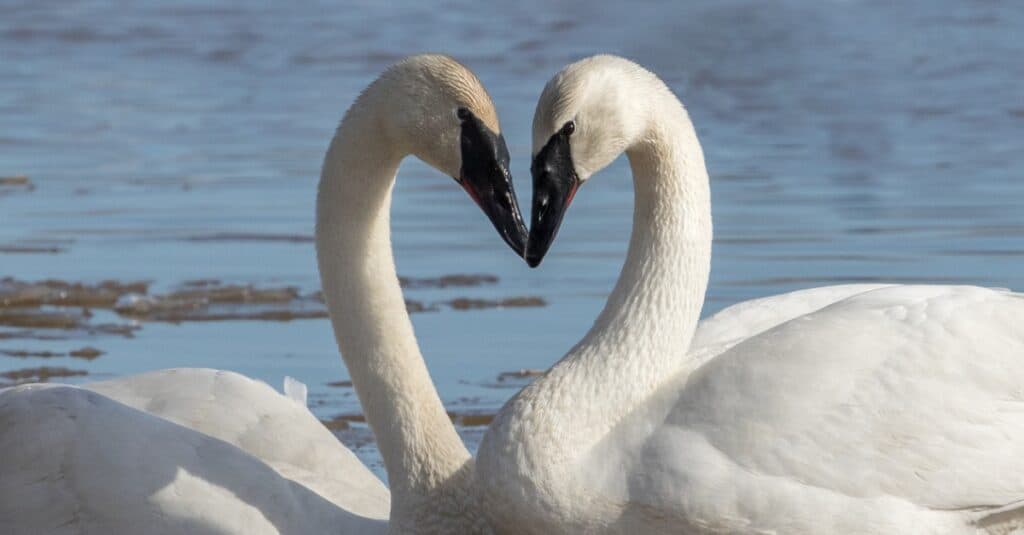
Trumpeter swans are exceptionally graceful birds.
©iStock.com/Dee Carpenter Photography
Another very large, white bird, the trumpeter swan is an exceptional addition to the different types of white birds on our list. They’re beautiful and elegant, and they weigh up to 28 pounds. The trumpeter swan shares a feature with the masked booby, in the precision black outline of its face, mostly around the eyes. It looks as though it is wearing a mask.
The trumpeter swan is one of the more graceful birds out there, white plumage or no, and there are reports of them growing as big as 6′ in length with 10’+ wingspans! They love the lake life and are primarily seen in lakes, marshes, and lazy rivers without much of a current.
11. Snow Goose (Anser caerulescens)
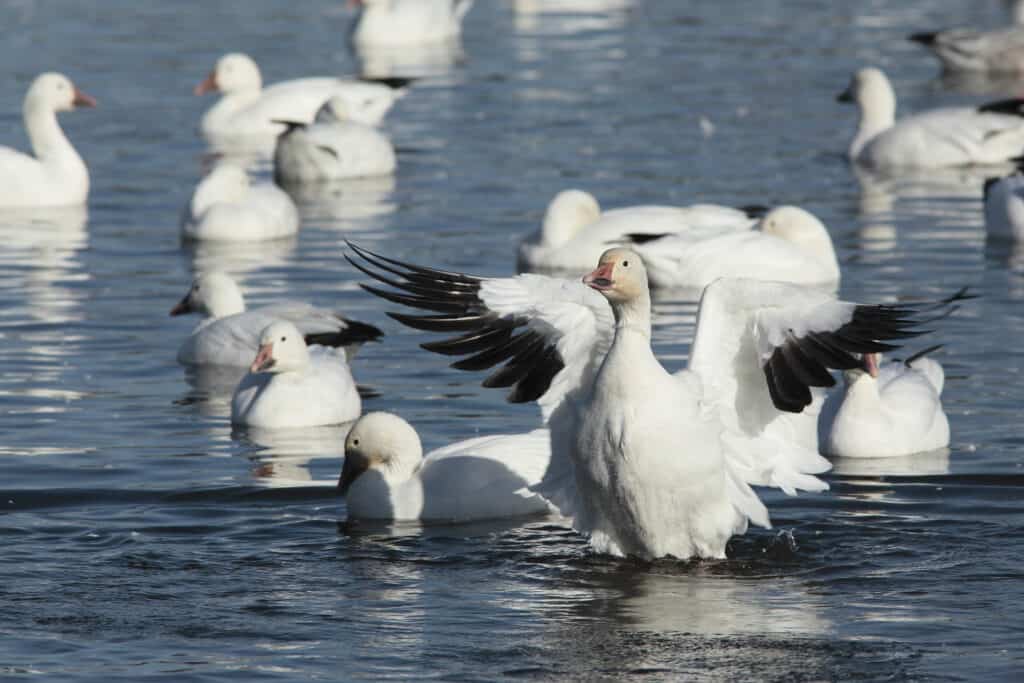
Snow geese can be pure white, but some have black feathers on their wings or torso.
©iStock.com/Michel VIARD
The snow goose is one of the most purely white birds on our list. It’s so white that it stands out against freshly fallen snow, which is pretty incredible. These dazzling creatures have a wingspan of up to 65″ and typically grow to a length of 25″ to 31″. There’s a large disparity of weights in the snow goose community, growing anywhere from 4 to 10 pounds.
Snow geese are usually found in the southern and central regions of the United States, along with Greenland, Canada, and Alaska. Despite being waterfowl, snow geese are often seen on farmlands and they prefer to build their nests high above the ground.
12. Glaucous Gulls (Larus hyperboreus)
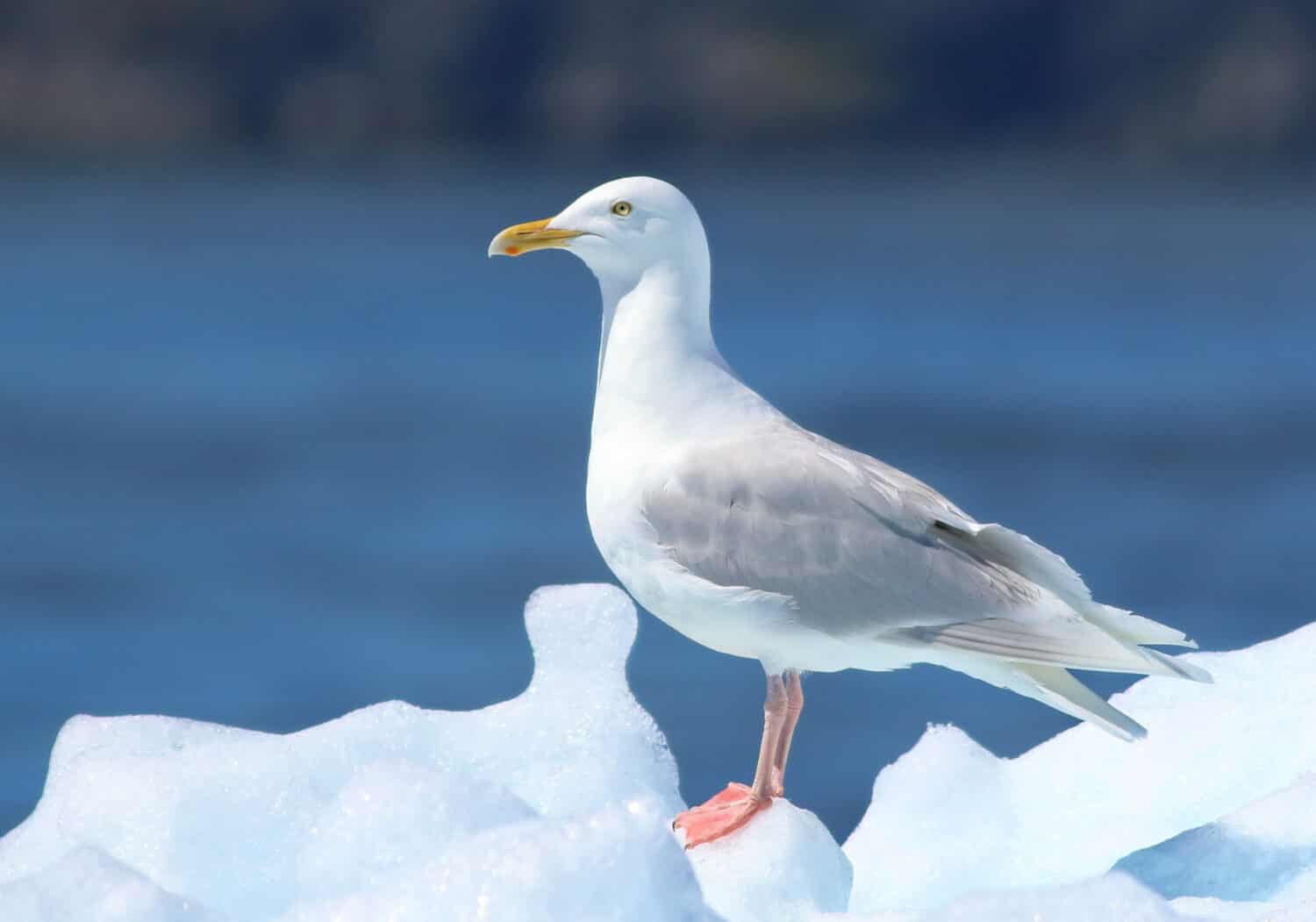
With a 68-inch wingspan, glaucous gulls are fairly large for seagulls.
©xpixel/Shutterstock.com
For a seagull, the glaucous gull is huge. Of course, seagulls are pretty large but most beachgoers are in for a shock when they spot a glaucous gull with a wingspan of 68″. They weigh between 3 and 4 pounds with a body length between 20″ and 31″. As large as they are, glaucous gulls are the second largest gulls in the world.
They are also the truest omnivores of the sky, eating almost anything they can get their beaks on. From insects, rodents, fish, and other, smaller birds, to plants and even carrion, if it’s edible, the glaucous gull will likely consume it with a high degree of enthusiasm.
13. American White Ibis (Eudocimus albus)
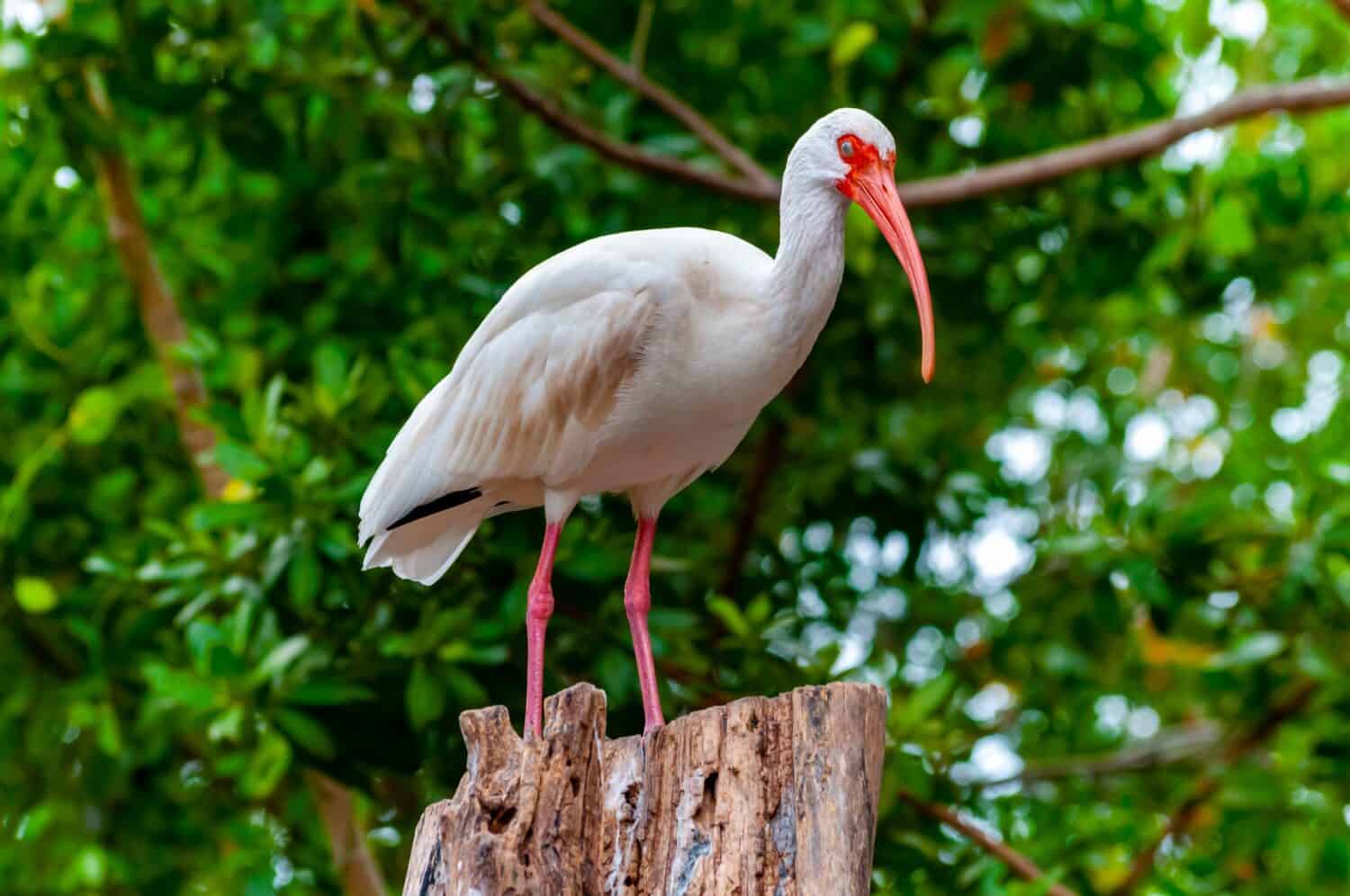
Preferring swamps and small creeks, you can find the American white ibis in Florida, Louisiana, and Texas.
©Oleg Kovtun Hydrobio/Shutterstock.com
The American white ibis largely resembles a heron or crane, except it has an extremely long, large, downward-curving beak. They have a wingspan of 35″ to 41″, a length of 20″ to 28″, and weigh anywhere between 1.5 and 3 pounds.
Like most cranes and herons, the American white ibis prefers swamps, small creeks, and shallow pools, with plenty of shallow water to wade through. The white ibis resides in the south, calling Florida, Louisiana, Texas, and the Carolinas home.
14. Mute Swan (Cygnus olor)

Weighing up to 35 pounds, mute swans are fairly large.
©Jim Nelson/Shutterstock.com
Mute swans are one of the largest on our list of different white types of birds, weighing up to 35 pounds. They have a wingspan between 75″ and 96″ and a body length between 50″ and 70″. Though they are often found in North America, the species was introduced to the continent two centuries ago.
They get their name thanks to their preference for remaining quiet and not making a lot of noise as they bask in the sunlight on the bank of a river. Their orange beaks separate them from some of the other geese on our list, but they retain the black masking look around the eyes.
15. Royal Spoonbill (Platalea regia)
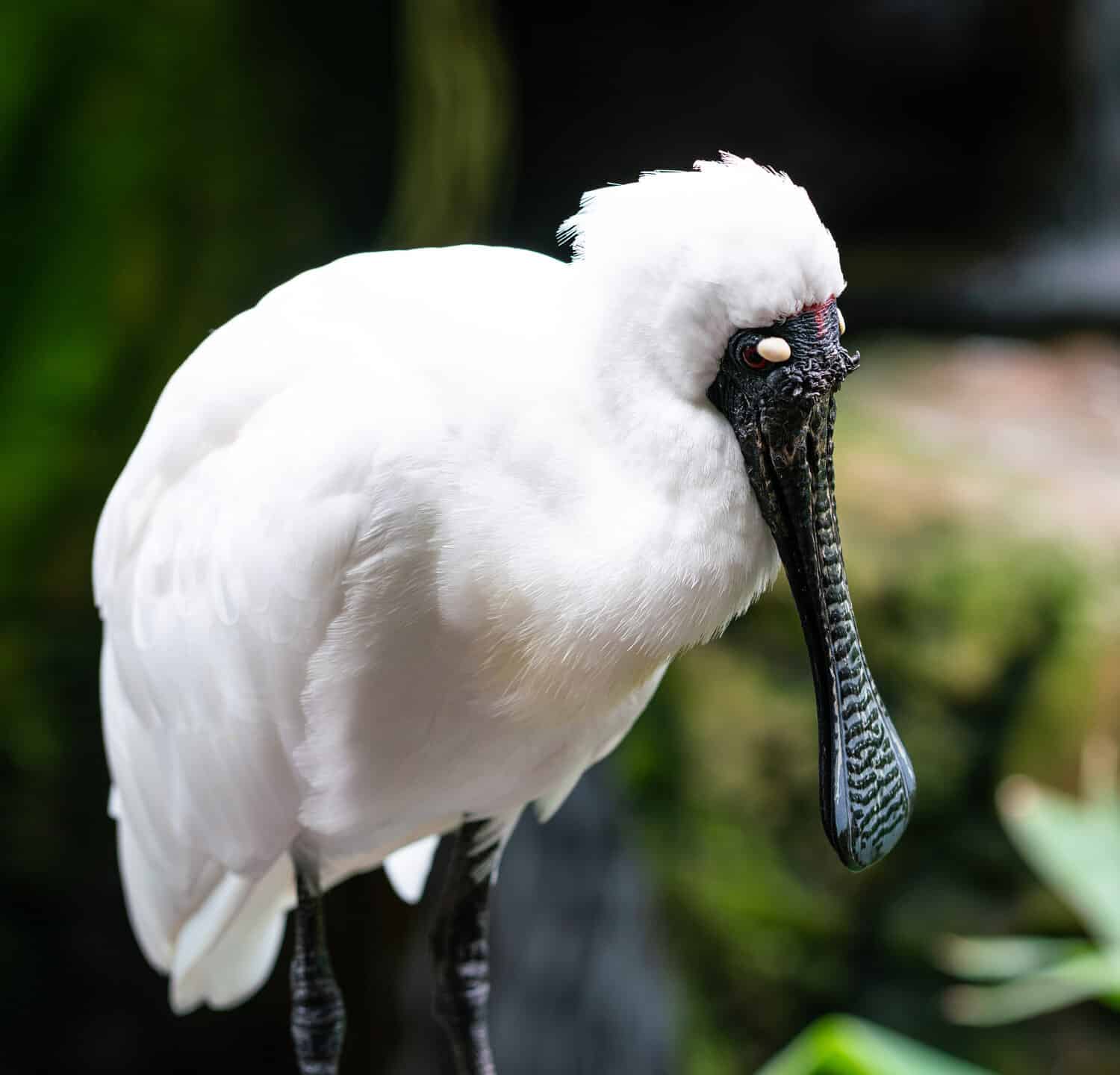
The black, spoon-shaped bill is a unique feature of the royal spoonbill.
©Keitma/Shutterstock.com
Last but not least, we have the royal spoonbill, another sizeable bird on our list of different types of white birds. Though their plumage is entirely white, the royal spoonbill features a huge, spoon-shaped black bill, along with crusty, long black legs.
The average royal spoonbill has a 45″ to 50″ wingspan, a body length of 29″ to 33″, and weighs up to 5 pounds. They sprout even more white feathers (in a spiky crown on their heads) during the breeding season. Their primary diet consists of shellfish but they aren’t averse to eating the occasional amphibian or two.
Final Thoughts
These 15 birds feature entirely white plumage or the vast majority of their feathers are white. Since white isn’t necessarily a color, it may seem like a pretty boring aesthetic. However, these are some of the most beautiful birds out there, and their white plumage is far from a detrimental factor.
Except for the Phillippine Cockatoo, most of them are fairly large birds, some of which are considered giants of the species. Seeing these birds in their natural habitat is almost always an awe-inspiring experience. They are easily some of the most vibrant and beautiful birds in the sky or on the ground.
Summary of the Beauty of White Birds: 15 Different Types and Their Stunning Features
| White Bird | Distinguishing Characteristic | |
|---|---|---|
| 1 | White Hawk | Black wings on a snowy white body |
| 2 | Ivory Gull | Entirely white with a gray beak |
| 3 | Snowy Owl | A randomized pattern of black markings amid the thick plumage |
| 4 | Great Egret | Mostly white with long legs |
| 5 | American White Pelican | White with a large yellow bill and big throat sack |
| 6 | Masked Booby | White with black masks and black wingtips |
| 7 | Phillippine Cockatoo | White with red undertail |
| 8 | Rock Ptarmigan | White with gray streaks and red over the eyes |
| 9 | Snowy Egret | Snowy white with glossy black legs and beak |
| 10 | Trumpeter Swan | Graceful white birds with black beaks |
| 11 | Snow Goose | These birds are so white that they stand out in the snow – also have black wingtips |
| 12 | Glaucous Gulls | Large white gulls with a 68 inch wingspan |
| 13 | American White Ibis | Large white bird with extremely long, curved red-orange beak |
| 14 | Mute Swan | Large white swan with orange beaks |
| 15 | Royal Spoonbill | Large white bird with sizeable black, spoon-shaped bill and black legs |
The photo featured at the top of this post is © Chelsea Sampson/Shutterstock.com
Thank you for reading! Have some feedback for us? Contact the AZ Animals editorial team.






